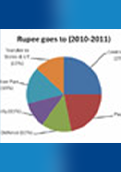India’s Defence Budget 2010-11: An Analysis
India's raised its defence budget for 2010-11 by 3.98 per cent to Rs. 1,47,377 crore. This allocation represents 2.12 per cent of gross domestic product (GDP), which is below the global average of 2.5 per cent. Considering the void in defence preparedness and the rising military expenditure and capability in neighbourhood, India needs to increase its defence spending to around 2.5-3.0 per cent of GDP. However, the increase in allocation has to go with reforms in capital acquisition system, which in present form is unable to spend the allocated resources.
- Laxman Kumar Behera
- April 2010











